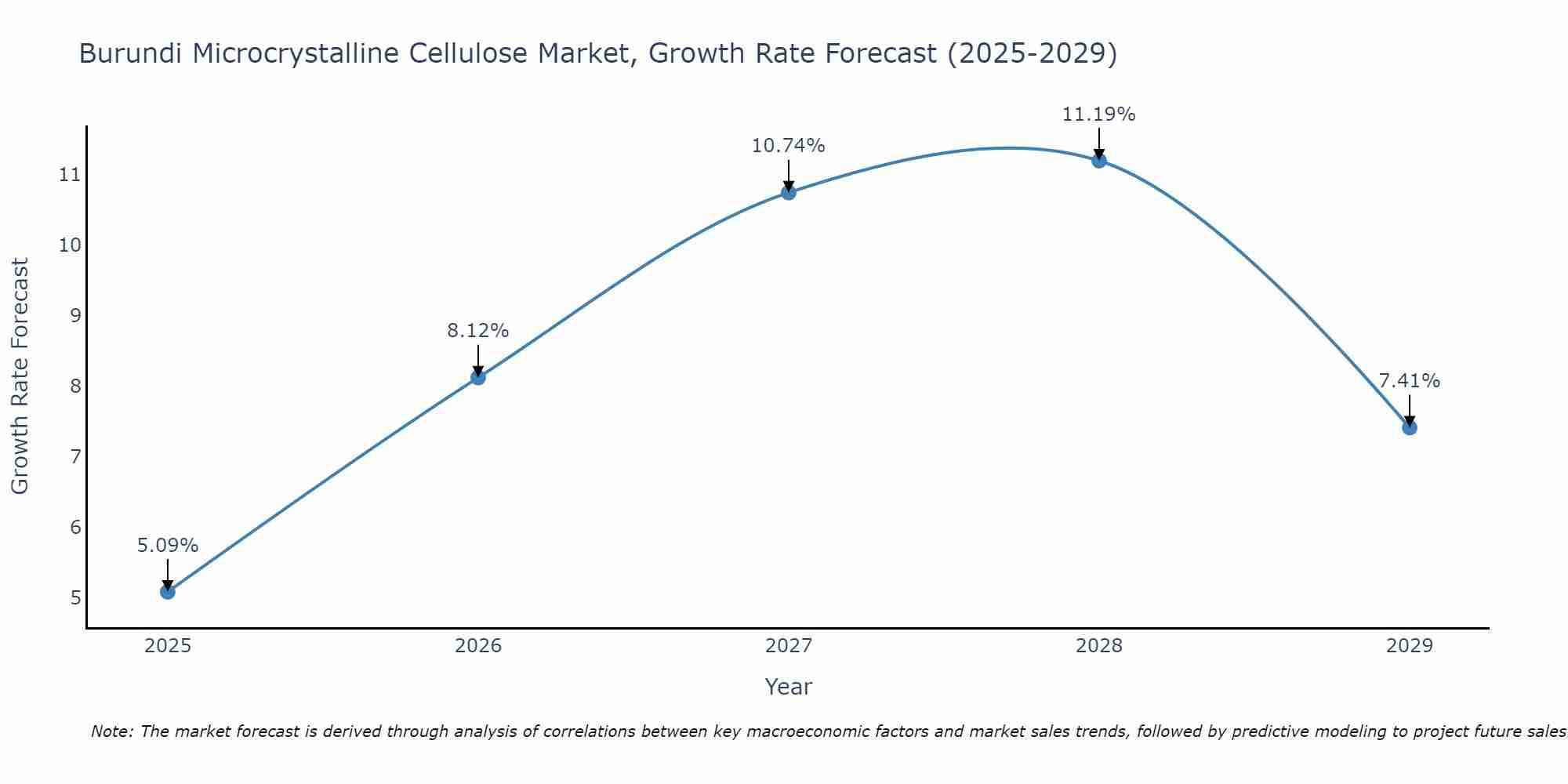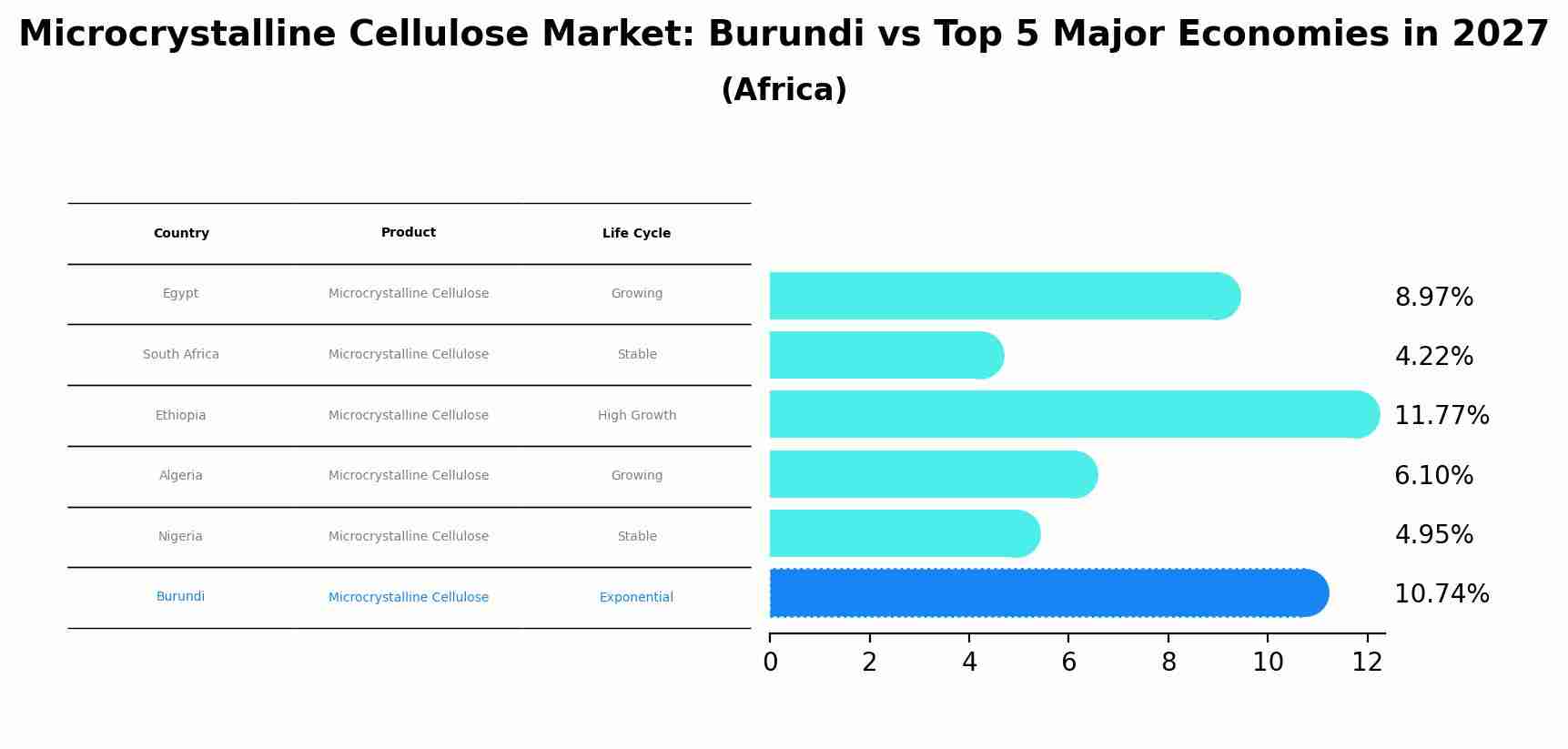Burundi Microcrystalline Cellulose Market (2025-2031) | Size, Analysis, Share, Value, Forecast, Trends, Growth, Segmentation, Industry, Companies, Outlook & Revenue
| Product Code: ETC4756625 | Publication Date: Nov 2023 | Updated Date: Apr 2025 | Product Type: Market Research Report | |
| Publisher: 6Wresearch | Author: Sachin Kumar Rai | No. of Pages: 60 | No. of Figures: 30 | No. of Tables: 5 |
Burundi Microcrystalline Cellulose Market Size Growth Rate
The Burundi Microcrystalline Cellulose Market is projected to witness mixed growth rate patterns during 2025 to 2029. Starting at 5.09% in 2025, the market peaks at 11.19% in 2028, and settles at 7.41% by 2029.

Microcrystalline Cellulose Market: Burundi vs Top 5 Major Economies in 2027 (Africa)
By 2027, the Microcrystalline Cellulose market in Burundi is anticipated to reach a growth rate of 10.74%, as part of an increasingly competitive Africa region, where Egypt remains at the forefront, supported by South Africa, Ethiopia, Algeria and Nigeria, driving innovations and market adoption across sectors.

Burundi Microcrystalline Cellulose Market Overview
The microcrystalline cellulose market in Burundi serves the pharmaceutical, food, and cosmetics industries. Microcrystalline cellulose is used as a filler, binder, and stabilizer, providing functional benefits in tablets, processed foods, and personal care products.
Drivers of the market
The Microcrystalline Cellulose market in Burundi is driven by the demand for this versatile material used in pharmaceuticals, food, and industrial applications. Microcrystalline cellulose is valued for its role as a binder, filler, and stabilizer in various products. The growth of the pharmaceutical, food, and personal care industries supports the demand for microcrystalline cellulose. Additionally, advancements in cellulose processing technologies and the development of new applications contribute to market growth.
Challenges of the market
The Microcrystalline Cellulose market in Burundi encounters obstacles such as high production costs and limited local manufacturing capabilities. Producing microcrystalline cellulose requires specialized technology and raw materials, which can be costly and difficult to obtain locally. Additionally, there is a need for better infrastructure and support services to facilitate the production and distribution of cellulose. The market also faces competition from alternative excipients and fluctuating demand in various applications.
Government Policy of the market
The Microcrystalline Cellulose market is shaped by policies related to material safety and industrial standards. The Burundian government enforces regulations to ensure the quality and safety of microcrystalline cellulose, with support for local industries involved in its production and trade.
Key Highlights of the Report:
- Burundi Microcrystalline Cellulose Market Outlook
- Market Size of Burundi Microcrystalline Cellulose Market, 2024
- Forecast of Burundi Microcrystalline Cellulose Market, 2031
- Historical Data and Forecast of Burundi Microcrystalline Cellulose Revenues & Volume for the Period 2021-2031
- Burundi Microcrystalline Cellulose Market Trend Evolution
- Burundi Microcrystalline Cellulose Market Drivers and Challenges
- Burundi Microcrystalline Cellulose Price Trends
- Burundi Microcrystalline Cellulose Porter`s Five Forces
- Burundi Microcrystalline Cellulose Industry Life Cycle
- Historical Data and Forecast of Burundi Microcrystalline Cellulose Market Revenues & Volume By Source Type for the Period 2021-2031
- Historical Data and Forecast of Burundi Microcrystalline Cellulose Market Revenues & Volume By Non-Wood Based for the Period 2021-2031
- Historical Data and Forecast of Burundi Microcrystalline Cellulose Market Revenues & Volume By Wood-Based for the Period 2021-2031
- Historical Data and Forecast of Burundi Microcrystalline Cellulose Market Revenues & Volume By End-use for the Period 2021-2031
- Historical Data and Forecast of Burundi Microcrystalline Cellulose Market Revenues & Volume By Binder/Diluent for the Period 2021-2031
- Historical Data and Forecast of Burundi Microcrystalline Cellulose Market Revenues & Volume By Bulking agent for the Period 2021-2031
- Historical Data and Forecast of Burundi Microcrystalline Cellulose Market Revenues & Volume By Emulsifiers for the Period 2021-2031
- Historical Data and Forecast of Burundi Microcrystalline Cellulose Market Revenues & Volume By Stabilizer for the Period 2021-2031
- Historical Data and Forecast of Burundi Microcrystalline Cellulose Market Revenues & Volume By Anti-Caking Agent for the Period 2021-2031
- Historical Data and Forecast of Burundi Microcrystalline Cellulose Market Revenues & Volume By Others for the Period 2021-2031
- Historical Data and Forecast of Burundi Microcrystalline Cellulose Market Revenues & Volume By Application for the Period 2021-2031
- Historical Data and Forecast of Burundi Microcrystalline Cellulose Market Revenues & Volume By Pharmaceutical for the Period 2021-2031
- Historical Data and Forecast of Burundi Microcrystalline Cellulose Market Revenues & Volume By Food & Beverage for the Period 2021-2031
- Historical Data and Forecast of Burundi Microcrystalline Cellulose Market Revenues & Volume By Cosmetics & Personal Care for the Period 2021-2031
- Historical Data and Forecast of Burundi Microcrystalline Cellulose Market Revenues & Volume By Paints & coatings for the Period 2021-2031
- Historical Data and Forecast of Burundi Microcrystalline Cellulose Market Revenues & Volume By Others for the Period 2021-2031
- Burundi Microcrystalline Cellulose Import Export Trade Statistics
- Market Opportunity Assessment By Source Type
- Market Opportunity Assessment By End-use
- Market Opportunity Assessment By Application
- Burundi Microcrystalline Cellulose Top Companies Market Share
- Burundi Microcrystalline Cellulose Competitive Benchmarking By Technical and Operational Parameters
- Burundi Microcrystalline Cellulose Company Profiles
- Burundi Microcrystalline Cellulose Key Strategic Recommendations
Frequently Asked Questions About the Market Study (FAQs):
1 Executive Summary |
2 Introduction |
2.1 Key Highlights of the Report |
2.2 Report Description |
2.3 Market Scope & Segmentation |
2.4 Research Methodology |
2.5 Assumptions |
3 Burundi Microcrystalline Cellulose Market Overview |
3.1 Burundi Country Macro Economic Indicators |
3.2 Burundi Microcrystalline Cellulose Market Revenues & Volume, 2021 & 2031F |
3.3 Burundi Microcrystalline Cellulose Market - Industry Life Cycle |
3.4 Burundi Microcrystalline Cellulose Market - Porter's Five Forces |
3.5 Burundi Microcrystalline Cellulose Market Revenues & Volume Share, By Source Type, 2021 & 2031F |
3.6 Burundi Microcrystalline Cellulose Market Revenues & Volume Share, By End-use, 2021 & 2031F |
3.7 Burundi Microcrystalline Cellulose Market Revenues & Volume Share, By Application, 2021 & 2031F |
4 Burundi Microcrystalline Cellulose Market Dynamics |
4.1 Impact Analysis |
4.2 Market Drivers |
4.3 Market Restraints |
5 Burundi Microcrystalline Cellulose Market Trends |
6 Burundi Microcrystalline Cellulose Market Segmentations |
6.1 Burundi Microcrystalline Cellulose Market, By Source Type |
6.1.1 Overview and Analysis |
6.1.2 Burundi Microcrystalline Cellulose Market Revenues & Volume, By Non-Wood Based, 2021-2031F |
6.1.3 Burundi Microcrystalline Cellulose Market Revenues & Volume, By Wood-Based, 2021-2031F |
6.2 Burundi Microcrystalline Cellulose Market, By End-use |
6.2.1 Overview and Analysis |
6.2.2 Burundi Microcrystalline Cellulose Market Revenues & Volume, By Binder/Diluent, 2021-2031F |
6.2.3 Burundi Microcrystalline Cellulose Market Revenues & Volume, By Bulking agent, 2021-2031F |
6.2.4 Burundi Microcrystalline Cellulose Market Revenues & Volume, By Emulsifiers, 2021-2031F |
6.2.5 Burundi Microcrystalline Cellulose Market Revenues & Volume, By Stabilizer, 2021-2031F |
6.2.6 Burundi Microcrystalline Cellulose Market Revenues & Volume, By Anti-Caking Agent, 2021-2031F |
6.2.7 Burundi Microcrystalline Cellulose Market Revenues & Volume, By Others, 2021-2031F |
6.3 Burundi Microcrystalline Cellulose Market, By Application |
6.3.1 Overview and Analysis |
6.3.2 Burundi Microcrystalline Cellulose Market Revenues & Volume, By Pharmaceutical, 2021-2031F |
6.3.3 Burundi Microcrystalline Cellulose Market Revenues & Volume, By Food & Beverage, 2021-2031F |
6.3.4 Burundi Microcrystalline Cellulose Market Revenues & Volume, By Cosmetics & Personal Care, 2021-2031F |
6.3.5 Burundi Microcrystalline Cellulose Market Revenues & Volume, By Paints & coatings, 2021-2031F |
6.3.6 Burundi Microcrystalline Cellulose Market Revenues & Volume, By Others, 2021-2031F |
7 Burundi Microcrystalline Cellulose Market Import-Export Trade Statistics |
7.1 Burundi Microcrystalline Cellulose Market Export to Major Countries |
7.2 Burundi Microcrystalline Cellulose Market Imports from Major Countries |
8 Burundi Microcrystalline Cellulose Market Key Performance Indicators |
9 Burundi Microcrystalline Cellulose Market - Opportunity Assessment |
9.1 Burundi Microcrystalline Cellulose Market Opportunity Assessment, By Source Type, 2021 & 2031F |
9.2 Burundi Microcrystalline Cellulose Market Opportunity Assessment, By End-use, 2021 & 2031F |
9.3 Burundi Microcrystalline Cellulose Market Opportunity Assessment, By Application, 2021 & 2031F |
10 Burundi Microcrystalline Cellulose Market - Competitive Landscape |
10.1 Burundi Microcrystalline Cellulose Market Revenue Share, By Companies, 2024 |
10.2 Burundi Microcrystalline Cellulose Market Competitive Benchmarking, By Operating and Technical Parameters |
11 Company Profiles |
12 Recommendations | 13 Disclaimer |
- Single User License$ 1,995
- Department License$ 2,400
- Site License$ 3,120
- Global License$ 3,795
Search
Thought Leadership and Analyst Meet
Our Clients
Related Reports
- Germany Breakfast Food Market (2026-2032) | Industry, Share, Growth, Size, Companies, Value, Analysis, Revenue, Trends, Forecast & Outlook
- Australia Briquette Market (2025-2031) | Growth, Size, Revenue, Forecast, Analysis, Trends, Value, Share, Industry & Companies
- Vietnam System Integrator Market (2025-2031) | Size, Companies, Analysis, Industry, Value, Forecast, Growth, Trends, Revenue & Share
- ASEAN and Thailand Brain Health Supplements Market (2025-2031) | Strategy, Consumer Insights, Analysis, Investment Trends, Opportunities, Growth, Size, Share, Industry, Revenue, Segments, Value, Segmentation, Supply, Forecast, Restraints, Outlook, Competition, Drivers, Trends, Demand, Pricing Analysis, Competitive, Strategic Insights, Companies, Challenges
- ASEAN Bearings Market (2025-2031) | Strategy, Consumer Insights, Analysis, Investment Trends, Opportunities, Growth, Size, Share, Industry, Revenue, Segments, Value, Segmentation, Supply, Forecast, Restraints, Outlook, Competition, Drivers, Trends, Demand, Pricing Analysis, Competitive, Strategic Insights, Companies, Challenges
- Europe Flooring Market (2025-2031) | Outlook, Share, Industry, Trends, Forecast, Companies, Revenue, Size, Analysis, Growth & Value
- Saudi Arabia Manlift Market (2025-2031) | Outlook, Size, Growth, Trends, Companies, Industry, Revenue, Value, Share, Forecast & Analysis
- Uganda Excavator, Crane, and Wheel Loaders Market (2025-2031) | Strategy, Consumer Insights, Analysis, Investment Trends, Opportunities, Growth, Size, Share, Industry, Revenue, Segments, Value, Segmentation, Supply, Forecast, Restraints, Outlook, Competition, Drivers, Trends, Demand, Pricing Analysis, Competitive, Strategic Insights, Companies, Challenges
- Rwanda Excavator, Crane, and Wheel Loaders Market (2025-2031) | Strategy, Consumer Insights, Analysis, Investment Trends, Opportunities, Growth, Size, Share, Industry, Revenue, Segments, Value, Segmentation, Supply, Forecast, Restraints, Outlook, Competition, Drivers, Trends, Demand, Pricing Analysis, Competitive, Strategic Insights, Companies, Challenges
- Kenya Excavator, Crane, and Wheel Loaders Market (2025-2031) | Strategy, Consumer Insights, Analysis, Investment Trends, Opportunities, Growth, Size, Share, Industry, Revenue, Segments, Value, Segmentation, Supply, Forecast, Restraints, Outlook, Competition, Drivers, Trends, Demand, Pricing Analysis, Competitive, Strategic Insights, Companies, Challenges
Industry Events and Analyst Meet
Whitepaper
- Middle East & Africa Commercial Security Market Click here to view more.
- Middle East & Africa Fire Safety Systems & Equipment Market Click here to view more.
- GCC Drone Market Click here to view more.
- Middle East Lighting Fixture Market Click here to view more.
- GCC Physical & Perimeter Security Market Click here to view more.
6WResearch In News
- Doha a strategic location for EV manufacturing hub: IPA Qatar
- Demand for luxury TVs surging in the GCC, says Samsung
- Empowering Growth: The Thriving Journey of Bangladesh’s Cable Industry
- Demand for luxury TVs surging in the GCC, says Samsung
- Video call with a traditional healer? Once unthinkable, it’s now common in South Africa
- Intelligent Buildings To Smooth GCC’s Path To Net Zero


















